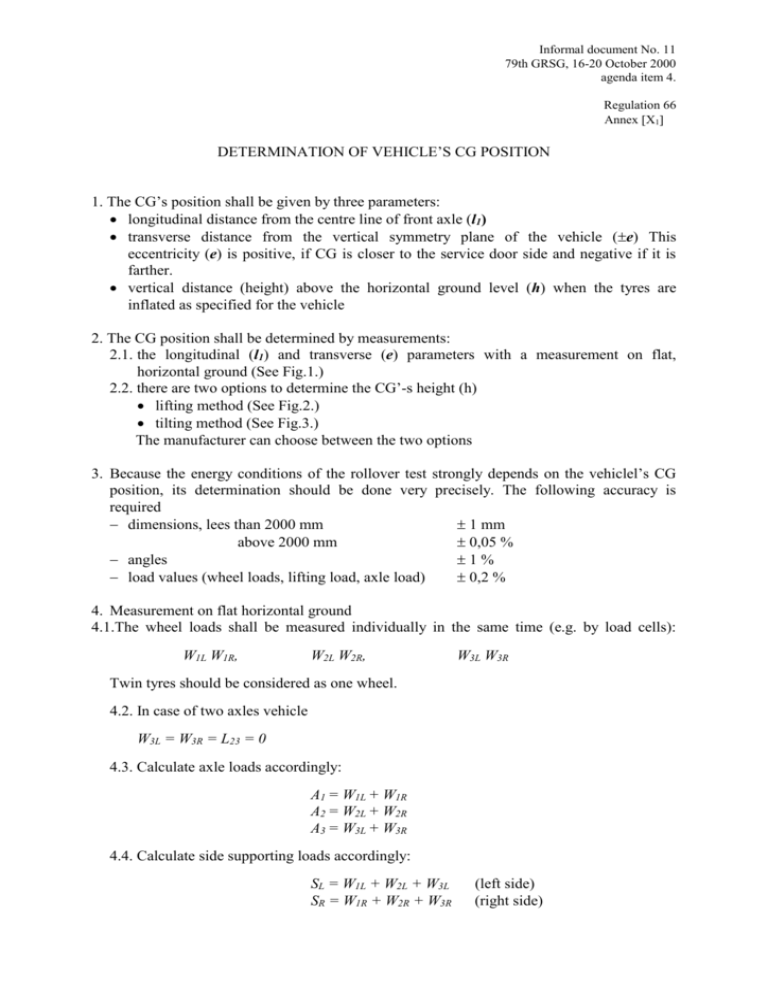Regulation 66
advertisement

Informal document No. 11 79th GRSG, 16-20 October 2000 agenda item 4. Regulation 66 Annex X1 DETERMINATION OF VEHICLE’S CG POSITION 1. The CG’s position shall be given by three parameters: longitudinal distance from the centre line of front axle (l1) transverse distance from the vertical symmetry plane of the vehicle (e) This eccentricity (e) is positive, if CG is closer to the service door side and negative if it is farther. vertical distance (height) above the horizontal ground level (h) when the tyres are inflated as specified for the vehicle 2. The CG position shall be determined by measurements: 2.1. the longitudinal (l1) and transverse (e) parameters with a measurement on flat, horizontal ground (See Fig.1.) 2.2. there are two options to determine the CG’-s height (h) lifting method (See Fig.2.) tilting method (See Fig.3.) The manufacturer can choose between the two options 3. Because the energy conditions of the rollover test strongly depends on the vehiclel’s CG position, its determination should be done very precisely. The following accuracy is required dimensions, lees than 2000 mm 1 mm above 2000 mm 0,05 % angles 1% load values (wheel loads, lifting load, axle load) 0,2 % 4. Measurement on flat horizontal ground 4.1.The wheel loads shall be measured individually in the same time (e.g. by load cells): W1L W1R, W2L W2R, W3L W3R Twin tyres should be considered as one wheel. 4.2. In case of two axles vehicle W3L = W3R = L23 = 0 4.3. Calculate axle loads accordingly: A1 = W1L + W1R A2 = W2L + W2R A3 = W3L + W3R 4.4. Calculate side supporting loads accordingly: SL = W1L + W2L + W3L SR = W1R + W2R + W3R (left side) (right side) 2 Regulation 66 Annex X1 4.5. Calculate unladen kerb mass accordingly: Mk = A1 + A2 + A3 = SL +SR 5. Determination of the longitudinal and transverse position of CG. Using the measured and calculated load parameters, as wall as the given geometrical values of the vehicle (See Fig.1.) 5.1. Calculate CG’s longitudinal position accordingly: A A l1 L23 3 L12 1 1 Mk Mk 5.2. Calculate CG’s transverse position accordingly: 1 SL e b 2 Mk where b is the average track of the axles, if b1, b2 and b3 is track of the first, second and third axle 1 b b1 b2 b3 3 6. Lifting test to determine CG’s height (see Figure 2.) 6.1. Lifting shall be done by both sides, both wheels of the second axle (e.g. by crane) in vertical direction. The spring system of the lifted axle should be sustained and the wheels of the first axle should be chocked. 6.2. The lifting height (m) have to result a lifting angle ( ) between 15o-20o. To ensure this lifting angle either a ditch should be used, or the front axle should be in an elevated position to overcome the limitation of the front angle of approach 6.3. Reaching the required lifting height the vehicle shall be held constantly in this position and the following values have to be measured: * exact lifting height (m) measured at the centre of the lifted axle wheels * vertical lifting load (A*2) * vertical supporting axle load at the front axle (A*1) 6.4.Control the measured loads, the sum of them shall be equal to the unladen, kerb mass: A*1 +A*2 = Mk 6.5. Calculate the exact lifting angle accordingly: m L12 arcsin 6.6. Calculate CG’s height accordingly: A* 1 h r h1 r l1 L12 2 M k tg 3 Regulation 66 Annex X1 where r is the static rolling radius of the front wheels when they are inflated as specified. The determination of r is shown on Fig.4. 4 Regulation 66 Annex X1 7. Tilting test to determine CG’s height (see Figure 3.) 7.1. The vehicle shall be placed parallel to the tilting axis on the tilting platform. The wheels should be supported against side slip. Three side supporting frames with padded heads should be applied to avoid rollover. 7.2. The distances between the padded heads and the side wall of the vehicle should be equal and in the range of 60-100 mm when the vehicle stands on the horizontal tilting platform. 7.3. All axles of the vehicle should be fixed, the spring system blocked 7.4. The tilting shall be done very slowly, until the unstable position of the vehicle. This position is reached, when: the wheels on one side do not touch the tilting platform anymore, the side supporting load on that side is zero the side wall of the vehicle touches the padded heads of the side supporting frames 7.5. Measure precisely the tilting angle () of the unstable position. Three measurements have to be carried out independently and the average value of the three tilting angle should be used for the calculation of CG’s height. 7.6. Tilting test shall be made on both directions determining two tilting angles: left side l and right side r 7.7. Calculate heights accordingly to both directions: hi b 2e 2 tg i where i and hi mean the appropriate values of the left and right side tilting test. 7.8. Calculate the CG’-s height: h hl hr 2 5 Regulation 66 Annex X1 6 Regulation 66 Annex X1







